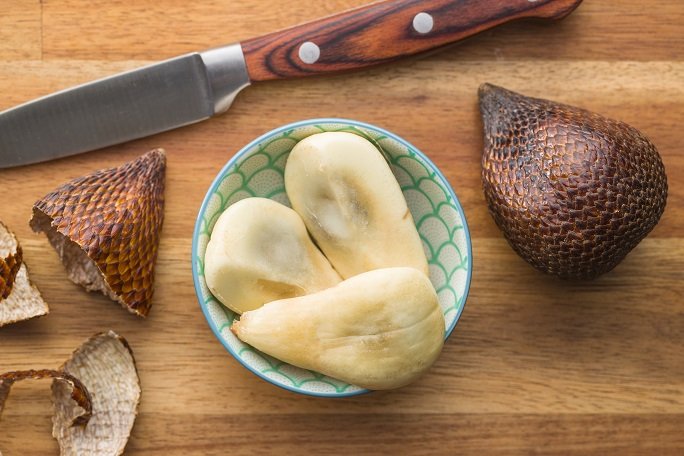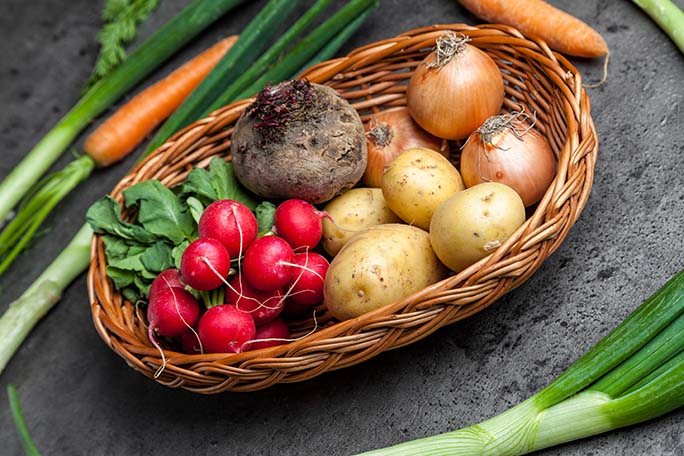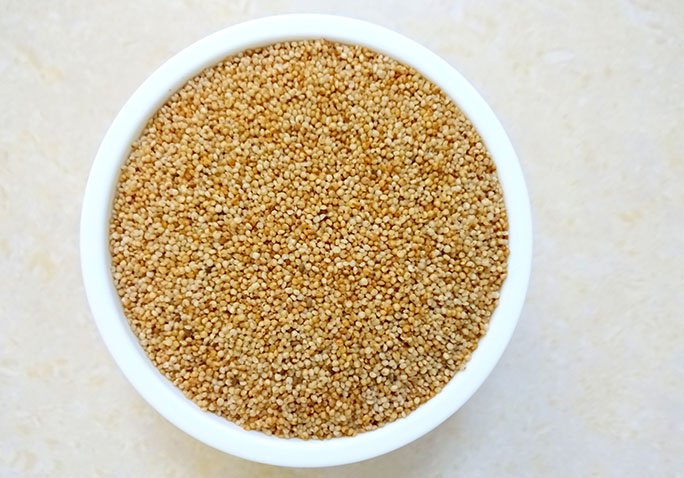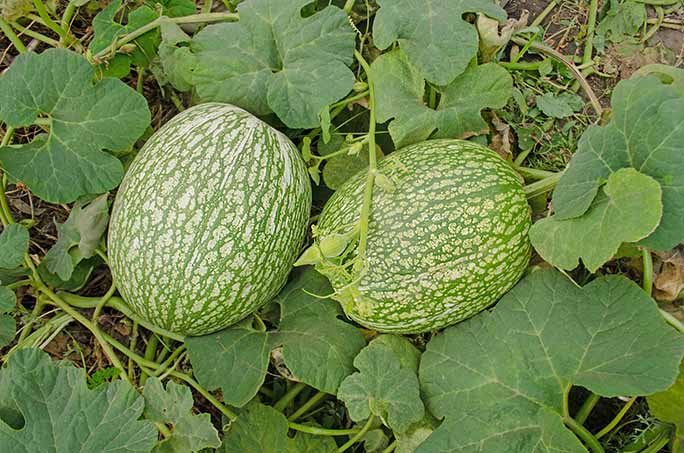When you visit the local fruit markets in Indonesia, Malaysia or Thailand, you may encounter a strange fruit that has a covering similar to that of Snake skin called Salak (Salacca zalacca). However, as the skin of the fruit resembles snake skin it is popularly known as Snake fruit.
Snake fruit is native to Java and Sumatra Islands of Indonesia and is a popular fruit almost across the Southeast Asian countries.

Snake Fruit
Salak Tree
This tropical tree is a small palm that is extremely spiny, growing in clumps and can reach up to a height of 6 meters. It is mainly cultivated in Southeast Asia for its fruits. These trees are also used as a hedge fence due to their spines and dense growth.
It has a very short stem and looks similar to a big areca palm (ornamental plant). Leaves are long and have a long spiny petiole. Roots of the salak tree are superficial and are not deep.
We can propagate this plant from seeds, stem cuttings or suckers. Flowering starts around 3 to 4 years if the plant is developed from seed and 2-3 years in case of stem cuttings or suckers.
Although salak trees grow in a wide range of soils, they prefer moist soils with organic matter and requires a good amount of shade for healthy growth. So they are usually intercropped with coconut, oil palm, cocoa, and rubber trees.
Snake Fruit
Snake fruits mature in 5-7 months after pollination and come in clusters of 15-40 fruits(Spadix) at the base of the tree. These fruits normally come in oval shape with a thin, strong, and scaly skin covering.The skin of the fruit comes in reddish brown to dark brown color and depends upon the variety and stage of fruit.
Inside, the fruit is arranged usually in three white colored segments that resemble the big garlic cloves. Each segment is covered by a very thin white colored translucent layer which should be rubbed off before eating.
These white segments contain a large dark brown colored seed which is inedible. Ripe salaks are soft, crunchy and taste sweet with acidic overtones and have a decent aroma and texture similar to a combination of pineapple, apple, and banana. If the fruits are unripe or immature they taste sour and acidic. Overripe fruits are usually tasteless.
Health Benefits of Snake Fruit
It is a great source of Anti-oxidants
Snake fruits are packed with good amounts of phenolic and flavonoid compounds which are well known for their antioxidant activity (1).
Even the peel of this fruit holds potential anti-oxidant properties and α-glucosidase inhibitory activity. This inhibitory activity of the peel is might be due to the compounds like Gallic acid, Linoleic acid, and α –tocopherol (2).
It may promote our Body health
Snake fruit peel extract may have a positive effect on the Immune system. As the peel extract had shown to enhance the phagocytic activity of macrophages and also stimulated the production of cytokines. Which plays an important role in our body’s defense system (3).
Anti-diabetic activity
Salak fruit has great importance as a traditional medicine for reducing blood glucose levels.
An in-vivo study conducted to known the anti-diabetic activity of Kombucha, a fermented beverage prepared from different snake fruit cultivars had shown a significant reduction in fasting plasma glucose (FPG), better lipid profile and lower oxidative stress in treated animals (4).
It may decrease Uric acid formation
Increased Uric acid levels in the blood(Gout) can cause several health complications like cardiovascular disorders
In such case, snake fruits may help you. The flesh of the snake fruit contains potential compounds that can inhibit Xanthine oxidase an enzyme that can lead to the production of reactive oxygen species which can further lead to the production of Uric acid (5).
Neuroprotective and Neuritogenic activity
salak fruit can be a potential source in preventing neurodegenerative disorders
A study conducted using pericarp extract of salak fruit has shown protective nature on neurons from oxidative stress and hydrogen peroxide toxicity. The study also says that the presence of phenolic and flavonoid compounds in the extract acted as signal molecules to increase the survival of neurons and promote neurite outgrowth (6).
Anticancer activity
Research conducted had proven that certain compounds present in snake fruit have cytotoxic activity.
β-Sitosterol a compound present in snake fruit extract had exhibited cytotoxic activity against breast cancer cell line MCF-7 and also against T47D- breast cancer stem cell line when tested in vitro (7).
Nutrition
Snake fruits are not only great in their flavor and taste but are also good at their nutritional value. They are a great source of phytochemical compounds like flavonoids and lignin’s that provide a wide range of benefits for our health.
They are also rich in potassium and contains minerals like calcium, phosphorous and sodium in considerable values. These fruits are high in carbohydrates and water content and low in protein and fats giving about 75-80 calories per 100 grams.
Storage and Consumption
Fresh fruits can last up to 7 days when stored at room temperate. However, fruits can remain fresh up to 3-4 weeks if you store at 15oC. Storing at low temperatures below 10oC can cause severe chilling injuries and discoloration of flesh.
Snake fruit is normally eaten fresh or cooked. They also have significant commercial value. Several value-added products are produced from it like juices, jams, candies, chips, and pickles.
In order to consume the fruits directly first tear the skin at the pointing end of fruit and peel of the skin. Now tear a segment and rub off the translucent covering over it. That’s it now you can enjoy the juicy sweet tasting flesh of salak fruit.







Comments